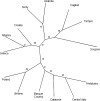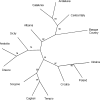Y-chromosome based evidence for pre-neolithic origin of the genetically homogeneous but diverse Sardinian population: inference for association scans
- PMID: 18183308
- PMCID: PMC2174525
- DOI: 10.1371/journal.pone.0001430
Y-chromosome based evidence for pre-neolithic origin of the genetically homogeneous but diverse Sardinian population: inference for association scans
Abstract
The island of Sardinia shows a unique high incidence of several autoimmune diseases with multifactorial inheritance, particularly type 1 diabetes and multiple sclerosis. The prior knowledge of the genetic structure of this population is fundamental to establish the optimal design for association studies in these diseases. Previous work suggested that the Sardinians are a relatively homogenous population, but some reports were contradictory and data were largely based on variants subject to selection. For an unbiased assessment of genetic structure, we studied a combination of neutral Y-chromosome variants, 21 biallelic and 8 short tandem repeats (STRs) in 930 Sardinian males. We found a high degree of interindividual variation but a homogenous distribution of the detected variability in samples from three separate regions of the island. One haplogroup, I-M26, is rare or absent outside Sardinia and is very common (0.37 frequency) throughout the island, consistent with a founder effect. A Bayesian full likelihood analysis (BATWING) indicated that the time from the most recent common ancestor (TMRCA) of I-M26, was 21.0 (16.0-25.5) thousand years ago (KYA) and that the population began to expand 14.0 (7.8-22.0) KYA. These results suggest a largely pre-Neolithic settlement of the island with little subsequent gene flow from outside populations. Consequently, Sardinia is an especially attractive venue for case-control genome wide association scans in common multifactorial diseases. Concomitantly, the high degree of interindividual variation in the current population facilitates fine mapping efforts to pinpoint the aetiologic polymorphisms.
Conflict of interest statement
Figures



Similar articles
-
A comparison of Y-chromosome variation in Sardinia and Anatolia is more consistent with cultural rather than demic diffusion of agriculture.PLoS One. 2010 Apr 29;5(4):e10419. doi: 10.1371/journal.pone.0010419. PLoS One. 2010. PMID: 20454687 Free PMC article.
-
Peopling of three Mediterranean islands (Corsica, Sardinia, and Sicily) inferred by Y-chromosome biallelic variability.Am J Phys Anthropol. 2003 Jul;121(3):270-9. doi: 10.1002/ajpa.10265. Am J Phys Anthropol. 2003. PMID: 12772214
-
Y-chromosome and Surname Analyses for Reconstructing Past Population Structures: The Sardinian Population as a Test Case.Int J Mol Sci. 2019 Nov 16;20(22):5763. doi: 10.3390/ijms20225763. Int J Mol Sci. 2019. PMID: 31744094 Free PMC article.
-
Non-random distribution of 17 Y-chromosome STR loci in different areas of Sardinia.Forensic Sci Int Genet. 2015 May;16:26-28. doi: 10.1016/j.fsigen.2014.11.019. Epub 2014 Nov 30. Forensic Sci Int Genet. 2015. PMID: 25498479
-
Investigation of extended Y chromosome STR haplotypes in Sardinia.Forensic Sci Int Genet. 2017 Mar;27:172-174. doi: 10.1016/j.fsigen.2016.12.009. Epub 2016 Dec 28. Forensic Sci Int Genet. 2017. PMID: 28057510
Cited by
-
Mendelian breeding units versus standard sampling strategies: Mitochondrial DNA variation in southwest Sardinia.Genet Mol Biol. 2011 Apr;34(2):187-94. doi: 10.1590/s1415-47572011000200003. Epub 2011 Apr 1. Genet Mol Biol. 2011. PMID: 21734814 Free PMC article.
-
Mitochondrial haplogroup U5b3: a distant echo of the epipaleolithic in Italy and the legacy of the early Sardinians.Am J Hum Genet. 2009 Jun;84(6):814-21. doi: 10.1016/j.ajhg.2009.05.004. Epub 2009 Jun 4. Am J Hum Genet. 2009. PMID: 19500771 Free PMC article.
-
Genome-wide scan with nearly 700,000 SNPs in two Sardinian sub-populations suggests some regions as candidate targets for positive selection.Eur J Hum Genet. 2012 Nov;20(11):1155-61. doi: 10.1038/ejhg.2012.65. Epub 2012 Apr 25. Eur J Hum Genet. 2012. PMID: 22535185 Free PMC article.
-
A comparison of Y-chromosome variation in Sardinia and Anatolia is more consistent with cultural rather than demic diffusion of agriculture.PLoS One. 2010 Apr 29;5(4):e10419. doi: 10.1371/journal.pone.0010419. PLoS One. 2010. PMID: 20454687 Free PMC article.
-
The high prevalence of hereditary spastic paraplegia in Sardinia, insular Italy.J Neurol. 2014 Jan;261(1):52-9. doi: 10.1007/s00415-013-7151-4. Epub 2013 Oct 20. J Neurol. 2014. PMID: 24141732
References
-
- Siniscalco M, Bernini L, Latte B, Motulsky AG. Favism and Thalassæmia in Sardinia and their Relationship to Malaria. Nature. 1961;190:1179–1180.
-
- Loudianos G, Dessi V, Lovicu M, Angius A, Figus A, et al. Molecular characterization of wilson disease in the Sardinian population–evidence of a founder effect. Hum Mutat. 1999;14:294–303. - PubMed
-
- Rosatelli MC, Meloni A, Devoto M, Cao A, Scott HS, et al. A common mutation in Sardinian autoimmune polyendocrinopathy- candidiasis-ectodermal dystrophy patients. Hum Genet. 1998;103:428–434. - PubMed
-
- Karvonen M, Tuomilehto J, Libman I, La Porte R. A review of the recent epidemiological data on the worldwide incidence of type 1 (insulin-dependent) diabetes mellitus. World Health Organization DIAMOND Project Group. Diabetologia. 1993;36:883–892. - PubMed
Publication types
MeSH terms
Substances
Grants and funding
LinkOut - more resources
Full Text Sources

